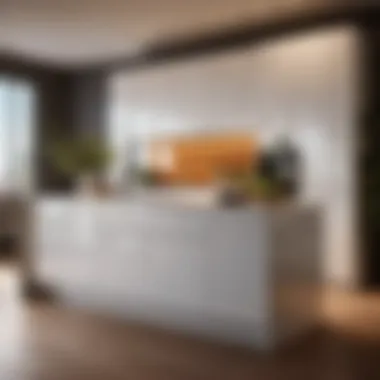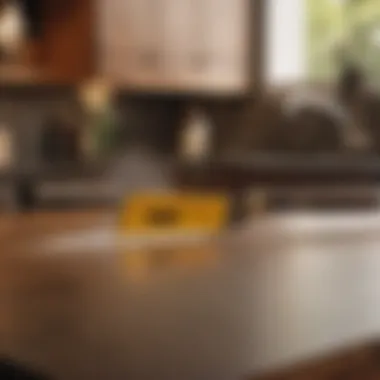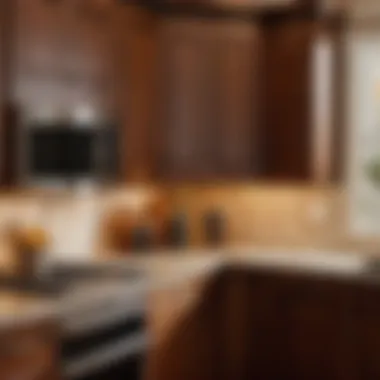A Comprehensive Guide on How to Reface Kitchen Cabinets for a Stunning Transformation


Materials:
- Cabinet doors (quantity will depend on the number of cabinets)
- Veneer or laminate sheets (ensure they can cover the cabinet frames)
- Adhesive or contact cement
- Veneer trim or wood molding
- Sandpaper (various grits)
- Tack cloth
- Wood filler
- Putty knife
- Utility knife
- Tape measure
- Level
- Pencil
- Screwdriver
DIY Steps:
- Measure the cabinets to determine the amount of veneer or laminate needed.
- Remove cabinet doors and hardware, ensuring they are labeled for easy reassembly.
- Clean cabinet surfaces thoroughly, removing grease and grime.
- Sand the cabinet frames lightly to prepare for veneer application.
- Cut veneer or laminate to size, leaving some extra for trimming.
- Apply adhesive to both cabinet frames and veneer/backing, then carefully press the veneer onto the frames.
- Trim excess veneer, sand edges, and apply wood molding or trim for a finished look.
- Reinstall cabinet doors, adjusting hinges as necessary.
Technical Aspects:
- Timing: Allocate 1-2 days for a standard kitchen with about 10 cabinets.
- Tools: Ensure you have a sharp utility knife for precise cutting and a level for accuracy.
- Techniques: Use even pressure when applying veneer to avoid air bubbles, and work in a well-ventilated area.
DIY Project Process:


- Begin with measuring and planning for accurate cuts and placements.
- Follow the step-by-step instructions carefully, ensuring a smooth and professional result.
- If facing challenges, use wood filler to correct small imperfections or consult a professional for guidance.
Troubleshooting Tips:


- If veneer does not stick, reapply adhesive and press firmly.
- To avoid uneven surfaces, sand with varying grits and finish with a fine grit for a polished look.
- For gaps or irregularities, use wood filler to smooth out the surface before adding trim.
Introduction


Refacing kitchen cabinets is a transformative and cost-effective way to revitalize your kitchen without the need for a full renovation. In this comprehensive guide on how to reface kitchen cabinets, we delve into the intricate process of enhancing your kitchen's aesthetic appeal and functionality. By following the steps outlined in this article, you can achieve a fresh and updated look for your kitchen space, potentially increasing the value of your home. Whether you are a seasoned DIY enthusiast or a homeowner considering a budget-friendly remodeling project, understanding the importance of refacing kitchen cabinets is pivotal for embarking on this exciting journey.
Key Elements of Introduction
What sets the introduction apart in this article is its focus on laying the foundation for a successful cabinet refacing project. By providing a thorough overview of the benefits, considerations, and steps involved, readers gain valuable insights into the intricate process ahead. The introduction serves as a guidepost, heralding the beginning of a transformative journey towards a rejuvenated kitchen space.
Benefits of Refacing Kitchen Cabinets
Among the myriad benefits outlined in the introduction, readers can grasp the potential cost savings, efficiency, and customization opportunities that come with refacing kitchen cabinets. Moreover, the introduction sets the tone for the meticulous planning required, ensuring that readers are well-equipped to navigate through the subsequent sections effectively. With an emphasis on detail and practical considerations, this guide aims to empower homeowners with the knowledge needed to undertake a successful cabinet refacing project.
Benefits of Refacing Kitchen Cabinets
Refacing kitchen cabinets presents a myriad of benefits that make it a highly attractive option for homeowners looking to revamp their kitchens without the hefty price tag of a full renovation. One of the key advantages of refacing cabinets is the cost-effectiveness it offers. As opposed to entirely replacing cabinets, refacing allows you to achieve a fresh, updated look at a fraction of the cost. This cost-effective nature makes cabinet refacing a practical choice for those working within a budget or seeking to maximize the value of their home.
Additionally, refacing kitchen cabinets is a time-efficient process. Unlike a complete cabinet replacement that can take weeks to accomplish, refacing typically can be completed in a matter of days. This quick turnaround is ideal for homeowners looking to refresh their kitchen's aesthetic without enduring an extended renovation period. Furthermore, the process of cabinet refacing is less disruptive than full-scale replacement, minimizing the inconvenience to occupants during the project.
Beyond financial and time considerations, refacing cabinets also contributes to sustainability. By refurbishing existing cabinets rather than discarding them, homeowners can reduce waste and minimize the environmental impact of their renovation projects. This eco-friendly aspect of cabinet refacing aligns with the growing trend of sustainable home improvement practices, appealing to environmentally-conscious individuals.
Moreover, refacing kitchen cabinets offers a customizable approach to design. With a wide range of materials, finishes, and hardware options available, homeowners can personalize their cabinets to suit their style preferences and complement their kitchen decor seamlessly. This level of customization empowers individuals to create a bespoke kitchen space tailored to their unique taste and vision.
In essence, the benefits of refacing kitchen cabinets extend far beyond mere aesthetics. From cost-effectiveness and time efficiency to environmental sustainability and design flexibility, cabinet refacing is a versatile solution that provides homeowners with a practical, customizable, and eco-conscious way to elevate their kitchen's appeal.
Planning Your Refacing Project
In the comprehensive guide on how to reface kitchen cabinets, planning your refacing project takes center stage as a crucial step towards achieving a successful cabinet transformation. This phase serves as the foundation upon which the entire project rests, emphasizing the need for meticulous preparation and thoughtful considerations.
Assessing Your Cabinets
Assessing your cabinets is a fundamental aspect of the planning process when embarking on a cabinet refacing project. Before diving into the reface, it is imperative to evaluate the current state of your cabinets. This includes examining the material quality, structural integrity, and overall condition to determine if they are suitable candidates for refacing. By assessing your cabinets thoroughly, you can identify any underlying issues that may need to be addressed before proceeding with the project.
Setting a Budget
Setting a budget is a critical component of planning your refacing project as it helps establish financial boundaries and allocate resources efficiently. When determining your budget, consider factors such as the cost of materials, labor expenses if hiring professionals, and any unforeseen contingencies. By setting a realistic budget from the outset, you can prevent overspending and ensure that the refacing project remains within your financial means.
Selecting Materials and Finishes
Selecting materials and finishes plays a significant role in the planning phase of cabinet refacing. The choice of materials, such as veneers or laminates, and finishes like paints or stains, can dramatically impact the final look and durability of your refaced cabinets. Consider factors such as design aesthetics, durability, and ease of maintenance when selecting materials and finishes to achieve your desired kitchen transformation.
Measuring and Ordering Supplies
Measuring and ordering supplies is a crucial step in the planning process to ensure a seamless refacing project. Accurate measurements of cabinet surfaces, doors, and hardware are essential for purchasing the right quantities of materials. Additionally, ordering supplies in advance allows for timely delivery and prevents unnecessary delays during the execution phase. By meticulously measuring and ordering supplies, you can streamline the refacing process and avoid common pitfalls associated with insufficient materials.
Preparing Your Kitchen for Refacing
In the comprehensive guide on how to reface kitchen cabinets, the section dedicated to preparing your kitchen for refacing plays a crucial role in ensuring a successful and seamless project. Before diving into the actual refacing process, proper preparation is essential to achieve professional-looking results and extend the longevity of the cabinet facelift.
One of the primary benefits of thoroughly preparing your kitchen for refacing is the ability to assess the condition of your current cabinets. This initial step allows you to identify any structural issues, damage, or areas in need of repair before applying new materials. Additionally, assessing your cabinets helps in determining the most suitable refacing techniques and materials to use based on the existing cabinet framework.
Another key aspect of preparing your kitchen for refacing is setting a designated budget for the project. By evaluating the scope of work required, including materials, labor, and any additional tools or supplies, you can establish a realistic budget to avoid overspending and ensure a cost-effective refacing process.
Selecting the appropriate materials and finishes during the preparation phase is crucial for achieving the desired aesthetic appeal and durability. Whether opting for veneer, laminate, or other refacing materials, careful consideration of your kitchen's style and existing decor is essential. Choosing high-quality finishes will not only enhance the overall look but also contribute to the longevity of the refaced cabinets.
Measuring and ordering supplies accurately is a critical step in the preparation process to prevent delays and ensure a smooth refacing project. Proper measurements of cabinet dimensions, door sizes, and hardware requirements help in avoiding costly mistakes and guarantee a precise fit for the new materials. By ordering supplies ahead of time, you can streamline the refacing timeline and minimize disruptions in your kitchen.
Clearing Out Cabinets
Clearing out cabinets is a fundamental aspect of preparing your kitchen for the refacing process. Before embarking on the renovation project, it is essential to declutter and empty the cabinets to access the surfaces easily and create a clean working environment. Removing all items stored inside the cabinets not only allows for better visibility but also protects your belongings from potential damage during the refacing process.
Clearing out cabinets involves systematically organizing and relocating the contents to temporary storage areas, such as boxes or designated spaces within your home. By categorizing items and labeling containers, you can ensure a smooth transition back into the newly refaced cabinets once the project is complete. This decluttering step also provides an opportunity to assess your kitchen essentials and consider decluttering or reorganizing as needed to optimize cabinet space.
Removing Cabinet Doors and Hardware
The process of removing cabinet doors and hardware is a critical stage in preparing your kitchen for refacing. By carefully dismantling existing doors, hinges, knobs, and handles, you pave the way for a clean slate to begin the refacing process effectively. Proper removal of these elements ensures thorough access to cabinet surfaces and facilitates the installation of new materials with precision.
When removing cabinet doors, it is essential to label each door and its corresponding hardware to maintain organization and simplify reinstallation later on. Creating a systematic approach to storing and labeling removed components streamlines the reassembly process and minimizes the risk of misplacing important parts. Additionally, inspecting the condition of hinges and hardware during removal allows for any necessary replacements or upgrades before reattaching them to the refaced cabinets.
Cleaning and Sanding Surfaces
Cleaning and sanding surfaces are essential preparatory steps in achieving a flawless finish during the cabinet refacing process. Before applying new materials, it is imperative to thoroughly clean the cabinet surfaces to remove any dirt, grease, or residues that may affect adhesion and finishing quality. Utilizing appropriate cleaning solutions and techniques ensures a smooth and contaminant-free surface for the refacing materials.
Sanding the cabinet surfaces is equally important to create a suitable texture for optimal bonding with the new veneer or laminate. Using fine-grit sandpaper, the surfaces are lightly abraded to promote adhesion and eliminate any existing finish or imperfections. This step not only enhances the durability of the refacing materials but also contributes to a professional-looking final result with seamless integration between the existing cabinets and the new facades.
Refacing Techniques
Refacing techniques play a pivotal role in achieving a successful and aesthetically pleasing cabinet makeover. By understanding the intricacies of refacing techniques, homeowners can elevate the overall look of their kitchen space without the need for a complete renovation.
When delving into refacing techniques, key elements to consider include the application of veneer or laminate, the installation of new cabinet doors, and updating hardware and fixtures. Each of these components contributes significantly to the final outcome of the cabinet refacing project.
Applying Veneer or Laminate
Applying veneer or laminate is a fundamental aspect of cabinet refacing that can instantly transform the appearance of existing cabinets. Veneer and laminate materials are versatile, coming in various finishes and styles to suit different design preferences.
To begin the process, meticulous measurements must be taken to ensure precise cutting and application of the veneer or laminate. Proper surface preparation is essential, including thorough cleaning and sanding to promote adhesion. Careful attention to detail during the application process is crucial for a seamless and professional finish.
Choosing the right veneer or laminate material is paramount, as it not only enhances the aesthetic appeal but also influences the durability and longevity of the refaced cabinets. High-quality materials combined with expert application techniques can result in a stunning cabinet facelift that breathes new life into the kitchen.
Installing New Cabinet Doors
Installing new cabinet doors can significantly impact the overall look and functionality of the cabinets. Whether opting for sleek modern designs or classic styles, selecting doors that complement the kitchen's theme is essential for a cohesive appearance.
Prior to installation, careful measurements must be taken to ensure the doors fit accurately and operate smoothly. Choosing hinges and hardware that align with the new doors is crucial for both aesthetic appeal and practicality. Attention to detail during the installation process is key to achieving a flawless end result.
New cabinet doors not only refresh the kitchen's aesthetics but also offer an opportunity to improve storage efficiency and accessibility. With a wide range of door styles and finishes available, homeowners can customize their cabinets to reflect their personal taste and lifestyle.
Updating Hardware and Fixtures
Updating hardware and fixtures is the final touch that brings the entire cabinet refacing project together. Choosing hardware that complements the new cabinet doors and the overall kitchen design is essential for cohesiveness.
When updating hardware, consider factors such as style, finish, and functionality. Whether opting for contemporary handles or traditional knobs, consistency in design across all hardware components creates a unified and harmonious look.
Replacing outdated fixtures, such as hinges, drawer slides, and knobs, not only enhances the aesthetics but also improves the functionality of the cabinets. Investing in high-quality hardware ensures durability and longevity, adding value to the kitchen renovation project.
The careful selection and installation of hardware and fixtures contribute to the overall success of the cabinet refacing project, elevating the kitchen's appearance and functionality to new heights.
Finishing Touches and Maintenance
In the realm of refacing kitchen cabinets, the stage of finishing touches and maintenance holds crucial significance, as it adds the final polish to your project while ensuring the longevity and pristine condition of your cabinets. While refacing already brings a breath of fresh air to your kitchen, these finishing touches elevate the overall aesthetics and functionality to new heights.
When it comes to finishing touches, one of the key elements is applying paint or stain. This step not only seals the newly-refaced surfaces but also provides a personalized touch to match your kitchen's décor and style. Whether opting for a sleek modern look with a coat of white paint or embracing the warmth of wood with a rich stain, the choice of finish can make a substantial impact on the final outcome.
Furthermore, adding decorative elements is another facet of finishing touches that can transform the entire look of your cabinets. From elegant cabinet knobs and handles to ornate trim and molding, these details inject character and flair into your kitchen space, elevating its visual appeal.
Apart from aesthetics, maintenance is paramount to preserve the beauty and functionality of your refaced cabinets. Caring for refaced cabinets involves simple yet essential tasks such as regular cleaning with gentle detergents, avoiding harsh chemicals that may damage the finish, and addressing any wear and tear promptly to prevent further deterioration. By incorporating a maintenance routine into your kitchen upkeep, you can extend the lifespan of your refaced cabinets and enjoy their fresh appearance for years to come.
Conclusion
Refacing kitchen cabinets is a transformative and highly rewarding project that can breathe new life into your kitchen space without the expense of a full renovation. Throughout this comprehensive guide, we have delved deep into the intricate process of cabinet refacing, from assessing your cabinets to applying the final finishing touches.
By following the steps outlined in this article, you can embark on your refacing journey with confidence, knowing the key considerations such as setting a budget, selecting materials, and measuring supplies have all been covered. Planning is essential for a successful project, and our guide ensures you are well-equipped to make informed decisions at every stage.
One of the key benefits of cabinet refacing is the cost-effectiveness it offers compared to a complete cabinet replacement. Not only does refacing save you money, but it also allows you to customize the appearance of your cabinets to suit your taste and style preference. This flexibility is a significant advantage for homeowners looking to upgrade their kitchen without breaking the bank.
Moreover, refacing your kitchen cabinets can boost the overall value of your home. Potential buyers are often attracted to kitchens with updated cabinets, and by investing in refacing, you are enhancing the aesthetics and functionality of one of the most important areas in a household.



